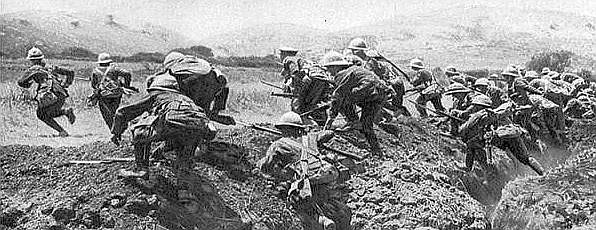
It evidently went through a very fierce battle. The battered flag, once fresh and colorful, is now faded, frayed and stained. It was no doubt that the flag bore witness to the brutalities of war. However, the flag, though old and tattered is still priceless. It was the first flag to be seen waving along the shores of the Gallipoli peninsula as the Aussie Diggers raced bravely to their mission. The flag, as with the Anzac, is legendary.
As soon as the soldiers stepped foot on Turkish soil, they were immediately pounded with heavy artillery. From that point, it was not clear how the 12th Battalion of the 3rd Brigade of the AIF was able to raise their flag. The flag which held the emblem of the AIF was thought to have been lost. Almost 100 years has passed and decades after the war, the flag now claims the centerpiece of the World War I exhibition in the Imperial War Museum in London. Being the highlight of the 100th anniversary of the Great War, the flag is now being restored.
The lead curator of the IWM First World War Gallery, Paul Cornish, said that the flag tells a story. He said that thousands of men of the AIF have died under the banner. The flag was their rally point although it was unclear how the men were able to fly it under heavy defense. He further said that it was also the first battalion to go on shore and their task as first line of assault was to shield the following landings. The museum also expressed that they wanted the flag for its significance. It is after all the first flag of the first brigade that symbolized the first Australian arrival in enemy territory.
An English soldier of the 29th Division collected the flag. He fought with the Anzacs during the war. However, the flag was not seen again for many years. Relatives discovered it from among their ancestor’s items and had it donated to the museum in 1990. The IWM had many items in their collection of Great War repositories. However, out of the thousands of historical items, the IWM picked the flag to be at the center of the display. The IWM underwent a multi-million dollar refurbishment to transform its gallery for the opening of the WWI commemoration this July.
Mr. Cornish also related the importance of telling the story of the Anzac to future generations. The story according to him is about Australia and New Zealand Army Crops joining the war. It is also a story of Gallipoli and Somme which form important elements of Australia.

Specialist textile curator Liz Rose is doing the daunting task of fixing the flag. She conserves the flag with utmost care as it is on the verge of being reduced to thread. The careful process takes days. She is careful though not to exclude the historic repairs and authentic tears that make the flag unique. Even the patch of an unknown repairer from years ago is left alone.
Rose said that the repair is merely to preserve and display it. But its condition is maintained as evidence of its history.
The 12th Battalion was almost made up of soldiers from Tasmania. The battalion was created three weeks after the declaration of war in August 1914. They were the the force to shield the other incoming forces for the Anzac landings. The battalion was thus the first to set foot on the shores at exactly 4:30 am on April 25, 1915. The battalion was headed by Lt. Col. L. F. Clarke. He was killed by a sniper during the first few hours of battle on shore. However, his men moved on with their mission. The two companies of the battalion even fought on Lone Pine later on. It was the only battalion in the brigade to be able to contribute a force that large. They were the last to leave Anzac Cove and they were the first to go into action in France in Somme Valley at Pozieres, Ypres in Flanders and to Amiens in August 1918.
A British officer wrote of the bravery of the Australians in the Gallipoli campaign. He wrote of how the men scaled the cliffs of Gallipoli while singing, “Australia will be there!”. Their motto, Ducit Amor Patriae or Love of My Country Leads Me, fueled the fervor of the 12th Battalion even when over half of the men were killed or wounded within the first five days of the campaign.
Other exhibitis include the German Po8 pistol discovered by a Queenslander from the 5th Light Horse Brigade Regiment in Palestine. He had the handle carved by a Turkish prishoner of war. Another part of the galleries of the IWM for the WWI commemoration are parts of the Manfred von Richthofen’s (Red Baron) biplane which was gunned down by the Australian troops. Other items include recruitment posters and uniforms originating from the WWI era. Other items are trench signs which include a Mouquet Farm sign also referred to by the Diggers as “Mucky Farm” near Pozieres where the Australian suffered 7,000 dead in only six weeks. This is equivalent to the dead in eight months of campaign in Gallipoli. Photographs documenting the war by Australian war photographer Frank Hurley will also go on display.
